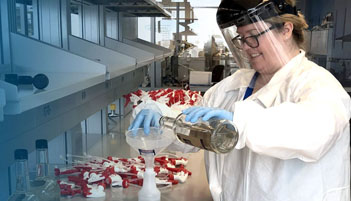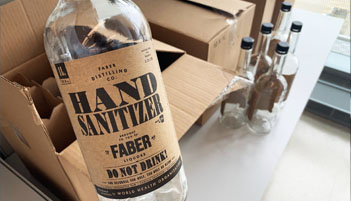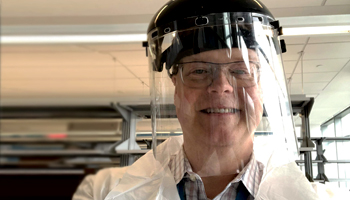HOW CAN WE HELP YOU? Call 1-800-TRY-CHOP
In This Section
In Sanitizer Shortage, CHOP Community Steps Up to Stay Resourceful

Volunteers across CHOP’s research community stepped up to provide patients and staff with safe and compliant hand sanitizer.
Volunteers from across Children’s Hospital of Philadelphia, outfitted from head to toe in personal protective equipment, are meeting throughout April in one of the Research Institute’s vacant lab spaces. Normally the site where scientists carry out their experiments, these days it’s the place for a lively production line where the volunteers help package the hand sanitizer that keeps our patients and staff safe every day.
The production line is just the last piece in a collaborative community effort in which departments across CHOP — from Environmental Health and Safety to Infection Prevention and Control — have mobilized and are leveraging their expertise in safety, compliance, and quick-thinking, to address the nationwide shortage in sanitizer.
“It really did come to happen very quickly,” said Denise Melvin, director of the Office of Research Safety and CHOP’s Institutional Biosafety Officer.
The swift response began when the community learned that much like other hospitals around the world, CHOP faced a dwindling and delayed supply of sanitizer due to coronavirus disease 2019 (COVID-19). A well-applied amount of hand sanitizer helps prevent transmission of the virus when soap and water are not readily available. But with CHOP’s Main hospital and other sites consuming 25 percent more sanitizer than usual due to COVID-19 precautions, a solution was needed, and fast.
CHOP’s Pharmacy Services and Supply Chain contacted Faber Liquor, a local distillery in Quakertown, PA, that manufactures an 80 percent alcohol-based sanitizer. Many distilleries can produce sanitizer because liquor and most sanitizers share the same key ingredient: ethyl alcohol.

Faber Liquor, a local distillery, manufactures an 80 percent alcohol-based sanitizer that is compliant with U.S. Food and Drug Administration guidelines as well as the World Health Organization’s (WHO) recommendations for sanitizer compounding.
Faber’s formula is compliant with U.S. Food and Drug Administration guidelines as well as the World Health Organization’s (WHO) recommendations for sanitizer compounding — and partnering with the distillery would be much more efficient than making sanitizer from scratch.
With a contract in place, Faber Liquor delivers sanitizer to CHOP. The problem: The liquid is packaged in 1-liter glass bottles not ideal for the hospital floor. These bottles present waste issues (since they are difficult to dispense) and safety issues (like the potential to break).
Enter our Office of Research Safety and Compliance teams.
As part of a high-performing Research Institute that oversees hundreds of wet lab operations every day, staff in these departments are experts in ensuring that operations are compliant with government regulations and adhere to the highest level of safety.
Brian Rounsavill, Supply Chain’s senior director for Contract and Procurement, coordinated the project from the Supply Chain end and was instrumental in working out the details with the distillery, contacting various vendors to obtain donated spray bottles, and collaborating with EMSCO, CHOP’s off site storage vendor to coordinate storage logistics. He contacted Melvin who offered expertise, lab space, and volunteers.
“The Environmental Health and Safety team is so involved on the clinical side with the bioresponse effort, and they’re right there on the front line, so I’m sure they decided to reach out to us knowing that we have expertise in chemical safety, that we monitor laboratory operations,” Melvin said.
All Hands on Deck

Matthew Hodgson, VP of Research Compliance, helps fill spray bottles of sanitizer.
Alongside Melvin and her Research Safety team, Matthew Hodgson, vice president of Research Compliance and Regulatory Affairs, and Ed Frackelton, Supply Chain category manager, developed a workflow for re-packaging the sanitizer from the glass bottles into 16 oz. spray bottles. Unlike glass containers, spray bottles can disperse sanitizer evenly and reduce waste. The team then enlisted help from volunteers in our research community — including themselves — to fill and label the spray bottles each week.
Within two hours of sending out the call for help, volunteers signed up to fill all 60 available time slots throughout April.
“It really spoke volumes to me about how willing people were to want to help and come in, and put the effort in,” Melvin said. “And as far as my [Research Safety Programs] team, it was really like, ‘We’re short of hand sanitizer. They need our help. What are we doing? Let’s hurry and figure it out.’ It took no convincing. It really made me feel proud.”
Covering Our Compliance and Safety Bases
Ensuring the safe storage and production of sanitizer is more nuanced and complicated than one might think: First, sanitizer is flammable, and moving large quantities of any high alcohol-based product can be dangerous. With the help of Brian Kovacs, senior safety manager and fire safety expert from Environmental Health and Safety, the team closely coordinated small deliveries and determined safe quantities to work with in the lab module itself.
Furthermore, Infection Prevention and Control implemented a 72-hour wait period before the spray bottles could be used to ensure spores are not present, which is a WHO compliance regulation, and directed the inclusion of packaging dates on each label (with labels produced by Pharmacy).
For Hodgson, the collaboration across CHOP and the Research Institute is something truly remarkable.
“People across the organization are being asked to find creative solutions to new problems —problems I don’t think we anticipated we’d ever face,” Hodgson said. “Before Supply Chain identified a distillery who could manufacture the hand sanitizer, we were exploring how the Research Institute could manufacture our own hand sanitizer! I have been impressed and humbled by the genuine interest of our employees to help in any way they are able to contribute.”
To date, the team has filled approximately 2,200 spray bottles in total, with the most completed in one day at a little over 800.
Over the first two days of production, with about five volunteers working at a time, they filled 1,500 spray bottles using 60 cases of liter bottles, which equals roughly two weeks’ worth of sanitizer.
The spray bottles will be delivered for use at CHOP’s Main hospital, and Melvin envisions that the production line will only get better, and more efficient, as the days go on.
“Now that we’re comfortable with it, and we’ve established the process, and we have some volunteers, I anticipate we could do a thousand in a day without problems,” Melvin said. “You could say in some sense, we’ve gotten better the more we’ve done it!”